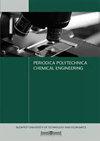Increasing Flame Ionization Detector Response by Silylation: The Effective Carbon Number of Carboxylic Acids
IF 1.8
4区 工程技术
Q3 ENGINEERING, CHEMICAL
引用次数: 0
Abstract
Detector response of carboxylic acids (C2–C12, straight and branched chain) were investigated using a flame ionization detector (FID) in a capillary gas chromatographic system. The response of the FID for hydrocarbons is almost directly proportional to the carbon quantity introduced into the flame. Heteroatoms in the molecule reduce signal magnitude, depending on their quality and on the bond they are involved in. We expressed this reduced response with the effective carbon number (ECN). We determined the ECN contribution (ΔECN) of the carboxyl group on the alkyl skeleton. We examined how the responses of carboxylic acids change if trimethylsilyl derivatives are evaluated and we compared the ECN of the neat and derivatized form.通过硅基化提高火焰电离探测器的响应:羧酸的有效碳数
在毛细管气相色谱系统中,利用火焰电离检测器(FID)研究了羧酸(C2-C12,直链和支链)的检测器响应。FID对碳氢化合物的反应几乎与火焰中引入的碳量成正比。分子中的杂原子会降低信号强度,这取决于它们的性质和它们所参与的键。我们用有效碳数(ECN)来表示这种减少的响应。我们确定了烷基骨架上羧基的ECN贡献(ΔECN)。我们研究了如果评估三甲基硅基衍生物,羧酸的反应如何变化,并比较了整齐形式和衍生形式的ECN。
本文章由计算机程序翻译,如有差异,请以英文原文为准。
求助全文
约1分钟内获得全文
求助全文
来源期刊

Periodica Polytechnica Chemical Engineering
ENGINEERING, CHEMICAL-
CiteScore
3.10
自引率
7.70%
发文量
44
审稿时长
>12 weeks
期刊介绍:
The main scope of the journal is to publish original research articles in the wide field of chemical engineering including environmental and bioengineering.
 求助内容:
求助内容: 应助结果提醒方式:
应助结果提醒方式:


